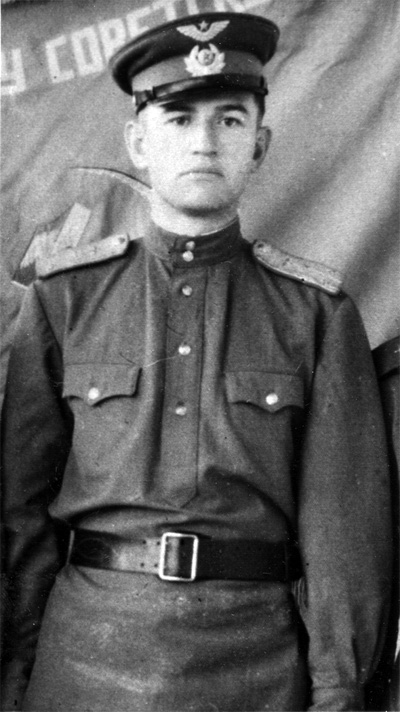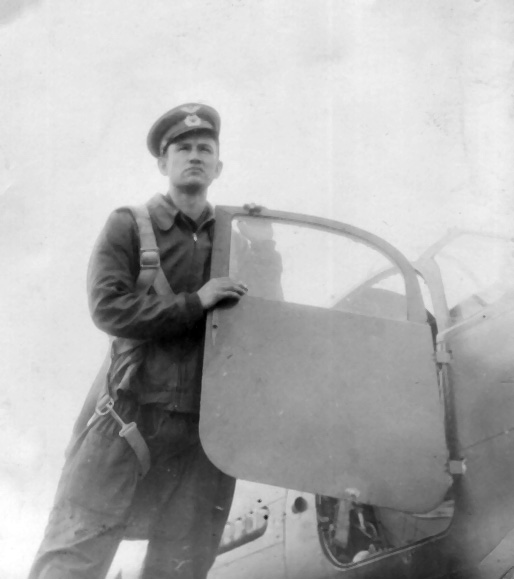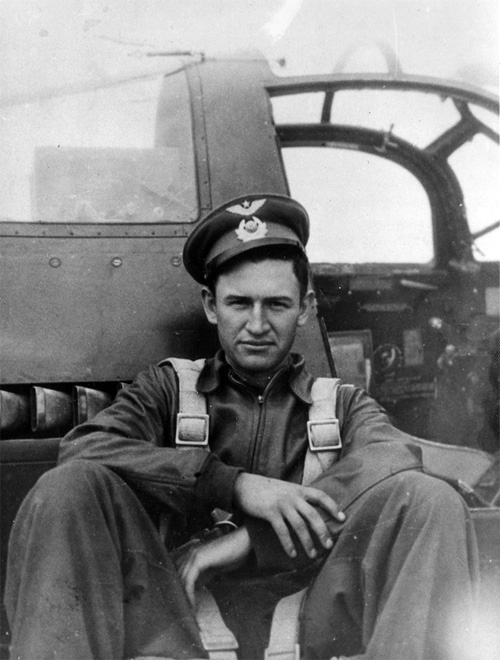4. After the war
— How long did you continue to train
pilots after the Victory?
ZAPs were disbanded in 1946. Our 25th ZAP
was transferred to Vaziani airfield, near Tbilisi. This transfer took a long
time, until the beginning of 1946. In the spring of 1946 our unit was
disbanded, all airplanes were signed off, and the personnel were either
demobilised or transferred to other units. I was sent to Armavir flight
school, to the posting of flight commander. In reality I did nothing at that
school, I didn’t even fly there. I was fed up with the ZAP, to say nothing
about flight school, so I applied for transfer to a combat unit. Only at the
end of September 1946 was I sent to the Far East, to the 5th IAP, 190th IAD.
— What was your rank then?
Lieutenant. I finished flight school with
the rank of junior lieutenant. I was promoted in the 25th ZAP on a special
occasion. I flew with a cadet in a UT-2 on a route flight along the Rion
River to the Black Sea coast. In the area of Samtredia, our engine stalled.
Our altitude was around 400 meters. Where could I land? The Rion River, the
cliffs? Then I spotted a chain of gardens. I managed to land there and
stopped just 10 meters short of a cliff’s edge. We even crossed ourselves. A
crowd of locals came running toward us, and started grabbing our plane. But
it was made of canvas. I thought – they are going to tear it apart. I
ordered to my cadet:
— Do not allow anybody to touch the plane – if you want to, beat them with a
stick.
I had to inform my commanders about what had happened, but there was no
radio. A Georgian took me across the river in a boat resembling Indian boats
– a large hollowed tree trunk. All the way I thought that we will turn over
and kept swearing, but everything ended well. We managed to complete our
trip safely and I called my superiors.
The regiment commander and engineer arrived at the end of the day. They
looked over the plane, and there was no damage. The regiment commander said
to me:
— For this we will promote you to the rank of lieutenant!
I said:
— I have already gone long past the time-in-grade requirement.
— I didn’t know!
And they finally promoted me to lieutenant.
— What duty position were you assigned
in the 5th IAP?
To the position of flight commander. I
served in the same squadron with flight commander Sutyagin, Nikolay
Vasilyevich. We flew together on King Cobras.

Flight commander Zavelin. 5
IAP, 1946
— Wasn’t Sutyagin born in Leningrad?
No, he was born in Nizniy Novgorod. He has
already passed away. He was a great pilot, a mature, quiet person, and a
good comrade. Fate had parted us in 1947, when the 5th IAP was disbanded.
— Why was it disbanded?
I think because of the reduction of armed
forces. There were a lot of reformations. It all started from the autumn of
1946, and finally the 5th IAP was disbanded in the summer of 1947. I was in
this regiment for half a year, and later I was transferred to the 821st IAP,
which was also in 190th IAD. Our regiment commander was Major Kryukov, and
we were stationed at village Voznesenskoye. This regiment was also equipped
with P-63 King Cobras.

5-th IAP. Kamen-Rybolov.
Zabelin at the wing of Cobra. 1947.
— What did you do for this year?
In the 5th IAP we trained like any other
combat unit. I can’t say how much we flew, maybe 40 or 50 hours per year.
This is low, very low flight time. American pilots had 500 hours flight
expeirience over the same time. We found out about it later. After they
finished flight school, they had 450 hours of flying time.
When I was transferred to the 821st IAP, we did the same – flew route
flights, gunnery practice, zone, even training dogfights.
— We were told that training flights
with planes of equal capability were ineffective.
I wouldn’t say so. You see, everything
depends on situational awareness; you have to train yourself to be able to
see and identify targets before they see you. This means victory or defeat.
— But an airplane at long distanse is
nothing more then a black spot.
But it moves, and the sun may reflect from
it. We also practiced shooting at aerial targets–cones. Flying–tactical
exercises were conducted in regiments and divisions. Each air army,
division, and regiment was inspected annually by the VVS staff from Moscow,
under the supervision of some high-ranking officer. The exercises were
conducted in conjunction with ground forces. Near us, at Kamen–Rybolov, was
a tank division, with a strength of 15,000 men. They had their own
excercises, and we trained to cover them. We trained as much as we could.
— Which types of airplanes did you see
in the Far East?
Cobras, or to be exact, King Cobras, La-5
and -7, and Yaks. Bombers were represented by the Pe-2, Bostons, B-25s and
Tu-4s. The Navy had its own aviation. When war in Korea broke out, the Navy
was in the first line of defense, because the Americans were constantly
flying along our borders, and they kept crossing it.
And we lived such a peaceful life before the Korean War. There were no
worries; we lived as we wanted, and honestly thought that all wars were
over. Some of our pilots started to look for a place in civilian life where
they could work after all aviation had been disbanded.
— How did you find out about war in
Korea and what followed the news?
When two American Shooting Stars strafed
our regiment at the Sukhaya Rechka airfield, our command immediatelly sent
the 303rd IAD from Moscow, which already flew MiGs. (on
08.10.1950 at 16.17 local time two USAF F-80C “Shooting Star” fighters from
49 FBG had breached USSR air border and attacked an airfield “Sukhaya
Rechka” 100 kilometers away from it. This airfield belonged to the VVS TOF,
but right at this moment due to training procedure it was occupied by, 821
IAP 190 IAD. Mostly 1st Squadron of 821 IAP was hit. 7 airplanes were
damaged, 1 P-63 burned to the ground, the rest were repaired. No human
losses were suffered. F-80s made two strafing runs and returned to their
home base. I. Seidov.).
— What actually happened at Sukhaya
Rechka?
It was the end of 1950. The war in Korea
was already at full scale. We were ordered to start excercises wich required
working from unprepared airfields. It had become common. Our 821st Regiment
was transferred to Sukhaya Rechka. All three squadrons were on the ground at
the parking spaces. On October 8, two F-80 Shooting Stars came and attacked
our airfield. Official reports stated that one plane was blown up and six
were heavily damaged, while I saw that at least twelve planes were damaged
out of a regiment of 40 planes. In the official report, they made one pass
and left. In reality they made two passes. They shot up the King Cobras that
were lined up.

821-st IAP. Zabelin at the
wing of Cobra not long before American strafing of Sukhaya Rechka.
— Were they lost, or was it a
provocation?
They were not at all confused. It was a
provocation. They well knew what their target was. They flew over 100
kilometers beyond our border with Korea! They knew well. It was later made
up that they were young pilots, who had become lost. Complete crap.
— Were there losses?
I know nothing about losses; at least no
one was killed. After this event, the 64th IAK was formed and we started to
rearm. Literally in two or three years, all Far Eastern aviation
transitioned to the new airplane. Before that, the Far East was considered
to be a secondary direction, and all new equipment was sent to Europe.
— We had no forces in Korea at that
time?
Our forces were in Korea after the Second
World War; they left in 1947, I think, but left all the equipment to the
Koreans. We had no planes on their airfields.
After Sukhaya Rechka was attaked, all regiments in the Far East were placed
on Alert-1, the first time since the end of the Second World War. From then
on – flights in Alert-1, squadrons on Alert-2. With no excuses. We sat near
our planes from dusk till dawn. A feeling of oncoming war appeared. The new
64th IAK was sent to Chinese and Korean airfields with a mission of covering
Chinese and Korean troops. Later I saw with my own eyes how they marched.
Their roads were awful at that time; they had no trucks, and they marched. A
division walked. 15,000 men carried huge loads, and they seemed to be very
small and thin, but they were very determined.
As long as they marched on Chinese territory, nobody touched them, but as
they crossed the Yalu River, they were bombed, even by B-29s. These bombers
tore the Korean land to pieces. On the railroads, rails were twisted like as
if they were thin wires.
Korea is a mountainous country, with a lot of tunnels. The Americans dropped
bombs very precisely. A figher–bomber came in at low altitude—at tree-top
level—and hurled their bombs literally not at the ground, but the bombs flew
right into the tunnels.
Troops could walk only at night, when they were attacked by B-26 Invaders.
They initially dropped illumination bombs, and then iron bombs. Kim Il Sung
and Mao Zsedun asked Stalin to provide their troops with cover, because
without it they couldn’t even move. And that’s when the North Koreans almost
won the war at the start. They sucessfully made it to Pusan, but the
Americans landed an amphibious assault and split Korea into two parts . They
made it to the Chinese border at the Yalu River.
That river was crossed by dams, and one of them was famous Suphum GES
[hydro-electric station]. I never saw such a huge dam. Its height was 90
meters! Can you imagine that? It supplied electricity for all of Korea and
northeast China. The Americans tried to destroy it, but our 64th IAK did not
allow them to do it.
It should be especially
noted, that Soviet military advisors warned North Korean military leaders
about such possibility. It was suggested that the territorial waters in this
area should be mined. Further more, TOF was prepared to supply the Koreans
with mines from it’s arsenals. For some reasons North Koreans did not use
this opportunity to defend themselves.
— Did you transition to MiGs straight
away, or were you still flying Cobras?
We flew King Cobras. We had begun to study
MiGs, when the 303rd IAD, under the command of General Lobov, was sent to
Korea.
— Do you remember what the regiment
designations were?
If I remember correctly, 17th, 18th and
523rd Regiments. They all came from Moscow PVO.
— When did you start flying MiGs?
We received first MiGs in early January
1951. My first flight in a MiG was made on January 13, 1951.
— Your first flight in a jet was made
on the MiG-15, or was it some other type?
We began training by flying the P-63 King
Cobra. Why? Because all our planes were tail draggers, while Cobras had nose
wheels. Several hundred P-63Us were made, and all pilots had to undergo
training in them. My first jet was a Yak-17. In the beginning of January we
flew the Yak-17 twice. Just to understand what a jet plane was!
— Did you learn anything from these two
flights?
Nothing. Not only me, and don’t forget
that I had vast flight experience, and I was an instructor myself for
several years. All we understood was the absence of the propeller and an
extended “box.”
— How did you receive your new MiGs?
Were they delivered in crates, or were they flown to the airfield?
They were brought in crates. We received
airplanes built at Komsomolsk-na-Amur.
— Were these MiG-15 or MiG-15Bis?
Bises. When we arrived at Myaogou, a
Chinese division was stationed next to us. Their planes were no farther then
50 meters away from our planes. Chinese technicians compared their planes
and ours. They bought our planes, but it was clear that they had received
another version – the exhausts on our plane were much bigger than on their
planes, and they couldn’t understand why this was so. But the most
unpleasant thing for Chinese pilots was the absence of hydraulic controls.
Their planes’ aerilons were not hydraulically assisted.
— How was your training organised?
There were no MiG-15UTIs yet.
No, there were no UTIs. At the beginning
we trained how to land at the speeds at which MiGs landed. And here we saw
our first problems. A pilot Maximov couldn’t get used to the high speed
landings, and finally after several attempts he crashed his plane.
Fortunately, he survived, and eventually he was signed off flying duty. We
studied theory, construction of the aircraft, and its equipment. Everything
seemed quite simple to us. But when we began flying it – everything was
quite different. I still remember my first “box” flight. I applied throttle,
and it suddenly started accelerating with tremendous rate. When I understood
what was going on, I was already at an altitude of 500 meters. Speed was
rising fast and I had to raise my landing gear and reduce throttle. There
was no propeller in front of me, and it made me feel uncomfortable about
reducing speed.
— How commonly did Americans breach our
borders?
We were in the second echelon. In front of
us were Navy pilots, also in the MiGs, and they were the first to intercept.
Some of their [the American] bombers or reconnaissance planes would fly over
Chukotka from Bering Strait, and then fly along our border. They flew just
outside our territorial limits, where they had the right to do so. Our
foreign office tried to make them stop these flights, but there was no
reaction. They even started flying over our airspace and it sometimes ended
with American planes being shot down. There always was a political stink
about such cases. I had to study in the academy with one regiment commander,
who was stationed on the Kurile Island closest to Japan (Shikotan). His name
was Anatoliy Kuznetsov, and he told me many interesting stories. One time a
pair of his pilots got so pissed with an American pilot’s actions that they
chased him to the northernmost Japanese Island and shot him down there. It
resulted in a huge political scandal. A B-29 had crossed this island, and
even fired at MiGs. By Kuznetsov's words, one of them was even hit by a
large caliber bullet in the trailing edge of the wing. MiG pilots made a
combat turn and chased the B-29 to the Japanese islands, making couple of
firing passes each, and they saw how the crew of the bomber bailed over the
shore line.
The event described
above most likely happened on 7 Nov. 1954 an RB-29 of the 91st SRS was shot
down by Mig-15s over the Kurile Islands. This was the famous “TIGER LIL”,
the aircraft which flew reconnaissance missions during the Korean War.
Apparently RB-29 4000 was conducting routine photographic reconnaissance
near Hokkaido and the southern most of the disputed Kurile Islands. The
plane was attacked and seriously damaged, forcing the crew to bail out. Ten
crewmen were successfully rescued after landing in the sea: however the
eleventh man drowned when he became tangled in his parachute. The Russian
reported the RB fired first, they returned the fire, downing the plane.